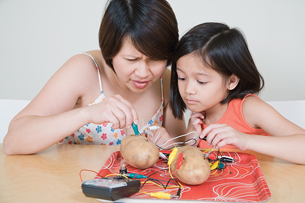Module 4
1. Module 4
1.28. Module Summary/Assessment
Module 4—Batteries and Balance
 Module Summary
Module Summary
In this module you investigated technological applications of the scientific principles associated with reduction–oxidation reactions.
You considered the following module question:
- How are principles of oxidation and reduction applied to electrochemical cells?
You used your understanding of electron transfer reactions and skills and techniques to predict, explain, and interpret chemical changes in order to investigate electric (e.g., voltaic) and electrolytic cells.
As you found with the chemical systems you investigated in Module 3, the chemical behaviour of both electric and electrolytic cells can be explained using half-reactions, net ionic equations, and cell potentials. You paid careful attention to the products and reactants in the equations you wrote. This allowed you to make observations that confirmed your predictions for both types of electrochemical cells.
You also learned to apply your knowledge of stoichiometry to reduction-oxidation reactions occurring in these cells. You extended your understanding of reaction chemical entities by using information about amperage and time to calculate moles of electrons participating in a chemical process. In the case of an electrolytic cell, you regarded electrons as the limiting reagent in the cell’s operation.
Concept Map or Graphic Organizer
As you worked through Module 4, you may have added information to a concept map or graphic organizer based on the module and lesson questions listed in the Module 4 Concept Organizer. Now is a good time to review the relationships in your concept map or graphic organizer and to try to answer the module and lesson questions.
A sample Module 4 concept map shows one set of possible links between the questions. Remember that this is one possible description only—there are many other correct possibilities. However, if your completed concept map or graphic organizer differs significantly from the sample, you may wish to contact your teacher or to compare your map or organizer with those of other students in your class. This will ensure that your interpretations of lesson materials and your descriptions are accurate.
![]](https://moodlehub.ca/pluginfile.php/3027/mod_book/chapter/6625/chemistry_30/ub/icons/assignment.gif) Module Assessment
Module Assessment

© 2008 Jupiterimages Corporation
When you were in elementary school, you might have constructed an electrochemical cell using a potato or a lemon. You have come a long way in understanding electrochemical cells. In this Assessment you will demonstrate your understanding of the scientific principles and technical knowledge involved in the design and operation of electrochemical cells.
With an electrochemical cell made from a potato or a lemon in mind, investigate ONE of the following research questions:
- Do all cells of this kind produce the same voltage?
- Do all cells of this kind operate for the same length of time?
- Can different voltages be recorded from cells constructed using the same fruit or vegetable?
- Is it possible to make these kinds of cells using a wide range of fruits and vegetables?
Read through the parts of conducting an experiment described in the table provided. Formally document your work in two of these steps, and submit your documentation to your teacher for assessment. Document your work in the format that best allows you to provide accurate, detailed, and complete descriptions of your work; e.g., video, audio, text, or a combination of formats.
Part |
Criteria |
Planning an Experiment |
|
Performing an Experiment |
|
Analysis of Experimental Work/Design |
|